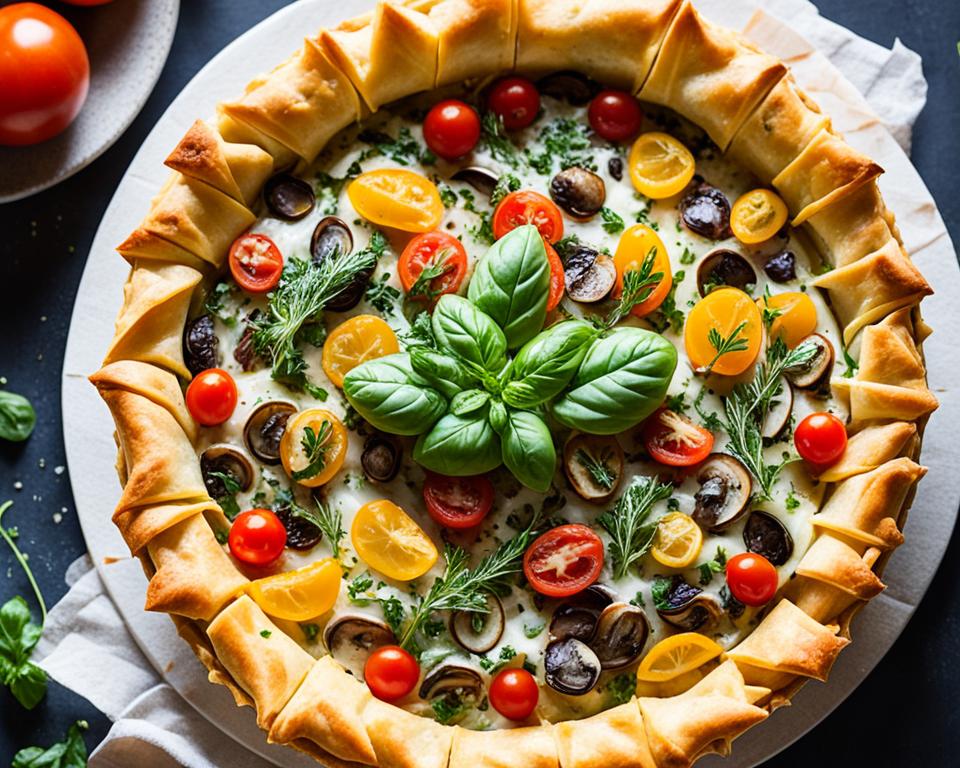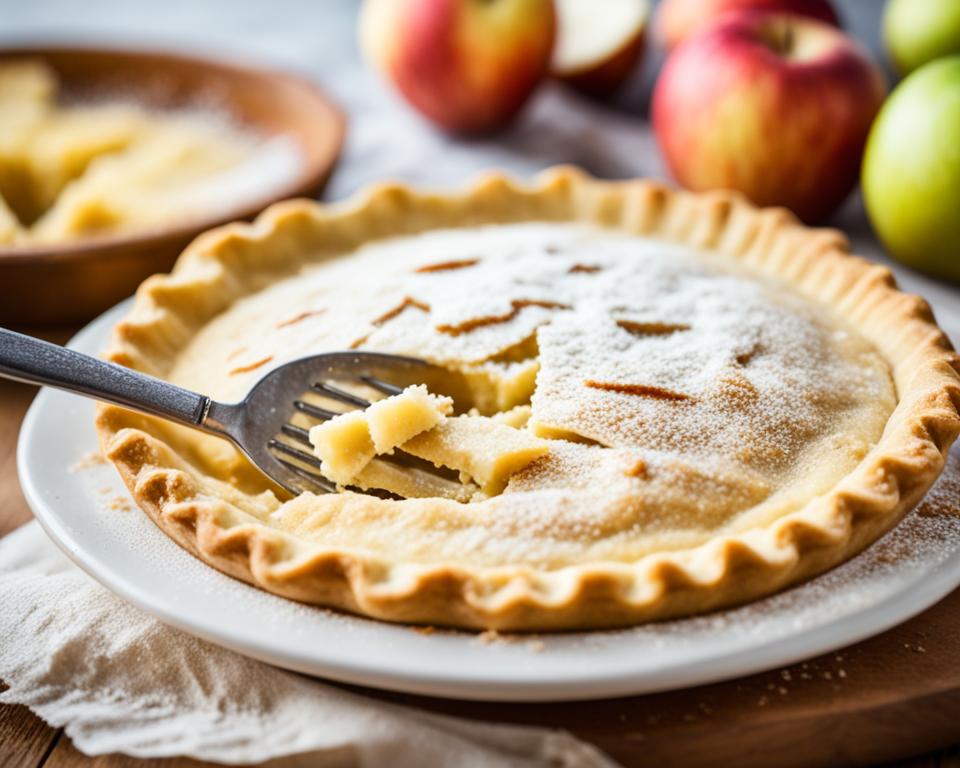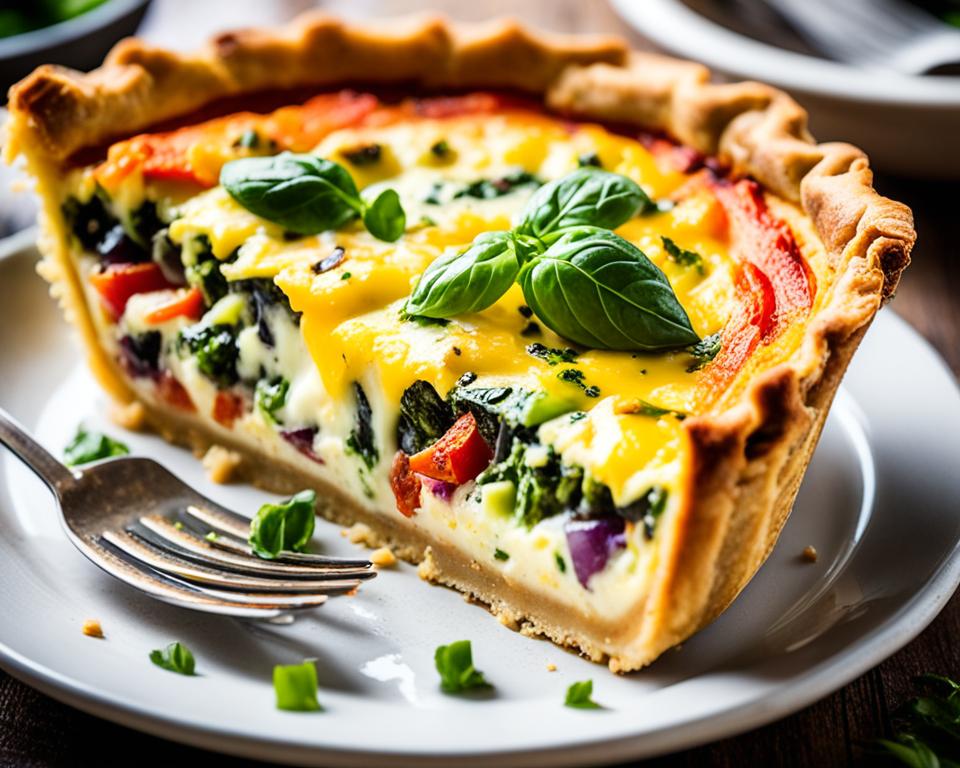Indulging in the deliciousness of samosas while following a gluten-free diet has never been easier. This article introduces you to delightful gluten-free samosas that are crispy, flavorful, and incredibly easy to make. Whether you have a gluten intolerance or simply prefer gluten-free options, these samosas are the perfect treat for you.
When it comes to flaky samosa recipes, look no further. We have crafted a simple and foolproof method that ensures a beautifully crisp exterior with a savory filling that will leave you wanting more. Not only are these samosas gluten-free, but they are also vegan, paleo-friendly, and bursting with delightful flavors.
The secret to our scrumptious gluten-free samosas lies in the filling. We use Wholly Veggie! ready-made veggie-full meals to create a delicious blend of sweet and spicy chickpea filling. These wholesome, all-natural meals are made with clean ingredients, guaranteeing a delightful taste and a guilt-free snacking experience.
Customization is key when it comes to these samosas. Feel free to experiment with different fillings, from traditional potato and pea to unique combinations of vegetables, cheese, or even meat. The options are endless, allowing you to personalize your samosas to suit your taste preferences.
No samosa is complete without a dipping sauce, and our gluten-free samosas are no exception. We provide a delectable tamarind dipping sauce recipe that perfectly complements the spiciness of the filling. The tangy and sweet flavors of the sauce add an extra dimension of taste to every bite.
Key Takeaways:
- Gluten-free samosas are a delightful snack for those following a gluten-free diet.
- These samosas are vegan, paleo-friendly, and incredibly easy to make.
- Wholly Veggie! ready-made veggie-full meals are the secret to a delicious and nutritious filling.
- Customize your samosas with different fillings, spices, and seasoning to suit your taste.
- Don’t forget the tamarind dipping sauce for that perfect finishing touch!
The Story Behind Gluten-Free Samosas
Samosas are a popular snack in Indian and Middle Eastern cuisines. These triangular-shaped pastries are filled with a variety of ingredients such as potatoes, peas, lentils, or meat. Traditionally, samosas are deep-fried and served with chutneys or dipping sauces, offering a perfect balance of flavors.
For individuals with gluten intolerance or those following a gluten-free diet, finding suitable gluten-free options can be challenging. That’s where gluten-free samosas come in. These delightful treats provide an alternative for those who want to enjoy the iconic flavors of Indian samosas while avoiding gluten.
Gluten-free samosas cater to various dietary preferences as well. They are an excellent choice for vegetarians and vegans who are looking for flavorful and satisfying options. By replacing traditional wheat-based dough with gluten-free alternatives, these samosas open up a world of delicious possibilities for individuals with dietary restrictions.
Whether you’re craving a tasty snack or searching for gluten-free options for your favorite Indian dish, gluten-free samosas are a fantastic choice. They offer all the elements that make samosas beloved, including the crispy texture and aromatic fillings, while being mindful of dietary needs.
Why Choose Gluten-Free Indian Snacks?
Gluten-free samosas provide a delicious and accessible option for individuals with gluten intolerance or following a gluten-free diet. They allow people to enjoy the classic flavors of Indian samosas without compromising on taste or dietary restrictions. Whether one is a vegetarian, vegan, or simply looking for a gluten-free snack, these samosas are a delightful choice.
Exploring the story behind gluten-free samosas highlights the versatility and inclusivity of Indian cuisine. By adapting traditional recipes to accommodate various dietary needs, Indian culinary traditions continue to evolve and offer diverse options for everyone to enjoy.
Next, we will delve into creating the perfect gluten-free samosa dough, ensuring that each bite is as flaky and indulgent as its gluten-filled counterpart.
The Perfect Gluten-Free Samosa Dough
Making gluten-free samosas at home usually involves preparing the dough from scratch. With this homemade samosa dough recipe, you can create delicious and gluten-free samosas with ease. The dough is made using a combination of gluten-free flours, ensuring a flaky and flavorful crust.
To make the gluten-free samosa dough, you will need the following ingredients:
- 1 cup corn flour
- 1 cup rice flour
- 1/2 cup tapioca flour
- 1/2 cup potato flour
- Water, as needed
Here’s how to prepare the dough:
- In a food processor, combine the corn flour, rice flour, tapioca flour, and potato flour. Pulse a few times to mix the flours together.
- Gradually add water, a little at a time, while pulsing the food processor. Continue adding water until the dough comes together and forms a ball.
- Transfer the dough to a clean surface and knead it gently for a few minutes, until it becomes smooth and pliable.
- Shape the dough into a ball and cover it with plastic wrap. Refrigerate the dough for at least 30 minutes to allow it to rest.
Once the dough has chilled, it’s ready to be used for making samosas. Take small portions of the dough and roll them out into thin rounds. The dough can now be filled with the sweet and spicy chickpea filling and folded into a triangular shape.
For a visual representation of the gluten-free samosa dough recipe, refer to the table below:
| Ingredients | Quantity |
|---|---|
| Corn flour | 1 cup |
| Rice flour | 1 cup |
| Tapioca flour | 1/2 cup |
| Potato flour | 1/2 cup |
| Water | As needed |

With this gluten-free samosa dough recipe, you can prepare homemade samosas that are flavorful, flaky, and perfect for those with gluten intolerance. Enjoy the process of making your own samosa dough and fill it with your favorite ingredients to create a truly delightful snack or appetizer.
The Sweet & Spicy Chickpea Filling
The filling for these gluten-free samosas is made with Wholly Veggie! Sweet & Spicy Chickpea veggie-full meal. This filling is made with chickpeas, tomatoes, butternut squash, lentils, spinach, chickpea balls, and red bell peppers. It has a perfect balance of sweet and spicy flavors. The filling is cooked with spices such as turmeric, fennel seed, cumin, coriander, and chili flakes. It is then combined with the mashed potatoes and peas to create a delicious and flavorful filling for the samosas.
Wholly Veggie! Sweet & Spicy Chickpea veggie-full meal is a convenient and nutritious option for creating gluten-free samosas. Made with wholesome ingredients, this filling provides a tasty and satisfying experience. The combination of chickpeas, vegetables, and spices adds a depth of flavor to the samosas. Whether you’re a vegetarian or simply looking for a gluten-free option, these samosas with sweet and spicy chickpea filling are sure to please.
With the Wholly Veggie! Sweet & Spicy Chickpea filling, you can enjoy the traditional flavors of Samosas while maintaining a gluten-free lifestyle. This delicious and vegetarian filling is packed with protein, fiber, and essential nutrients. The combination of hearty chickpeas, nutritious vegetables, and aromatic spices creates a well-balanced and flavorful filling for your samosas. Whether you’re hosting a party or craving a snack, these gluten-free samosas with sweet and spicy chickpea filling are sure to be a hit.
How to Shape Gluten-Free Samosas
Shaping gluten-free samosas involves folding the dough around the filling to create a triangular shape. There are different techniques to fold samosas, but the two most common ones are the half-moon shape and the triangle shape. The edges of the dough are moistened with water to help seal the samosas. The shaped samosas are then fried in oil until golden brown and crispy.
When shaping gluten-free samosas, it’s important to work carefully to ensure that the filling stays securely inside the dough. Here is a step-by-step guide on how to shape gluten-free samosas:
- Take a small portion of gluten-free samosa dough and roll it into a ball.
- Use a rolling pin to roll the dough ball into a thin round circle, ensuring that the edges are slightly thicker than the center.
- Cut the rolled dough in half, creating two semi-circles.
- Hold one semi-circle in your hand and fold it into a cone shape, overlapping the straight edges and sealing them well.
- Fill the cone-shaped dough with the sweet and spicy chickpea filling, ensuring not to overfill it.
- Moisten the edges of the cone lightly with water using your fingertip.
- Press the edges firmly together to seal the samosa, ensuring that there are no gaps or openings.
- Repeat the process with the remaining semi-circle and filling.
The shaped samosas are now ready to be fried to perfection. Heat oil in a deep pan or skillet and carefully lower the samosas into the hot oil. Fry them on medium heat until they turn golden brown and crispy. Remove the samosas from the oil using a slotted spoon and place them on a paper towel-lined plate to drain excess oil.
Shaping gluten-free samosas requires a bit of practice, but once you get the hang of it, it becomes an enjoyable process. The triangular shape not only adds visual appeal but also ensures that the filling is evenly distributed throughout the samosa. So, grab your dough, filling, and get ready to shape some delicious gluten-free samosas!
Tips for Shaping Gluten-Free Samosas:
- Ensure that the dough is rolled out thin but not too thin, as it may tear when folding.
- Seal the edges of the samosas well to prevent the filling from leaking out during frying.
- If the dough becomes dry and difficult to handle, lightly brush it with water to make it more pliable.
- Experiment with different shapes and sizes to create unique variations of samosas.
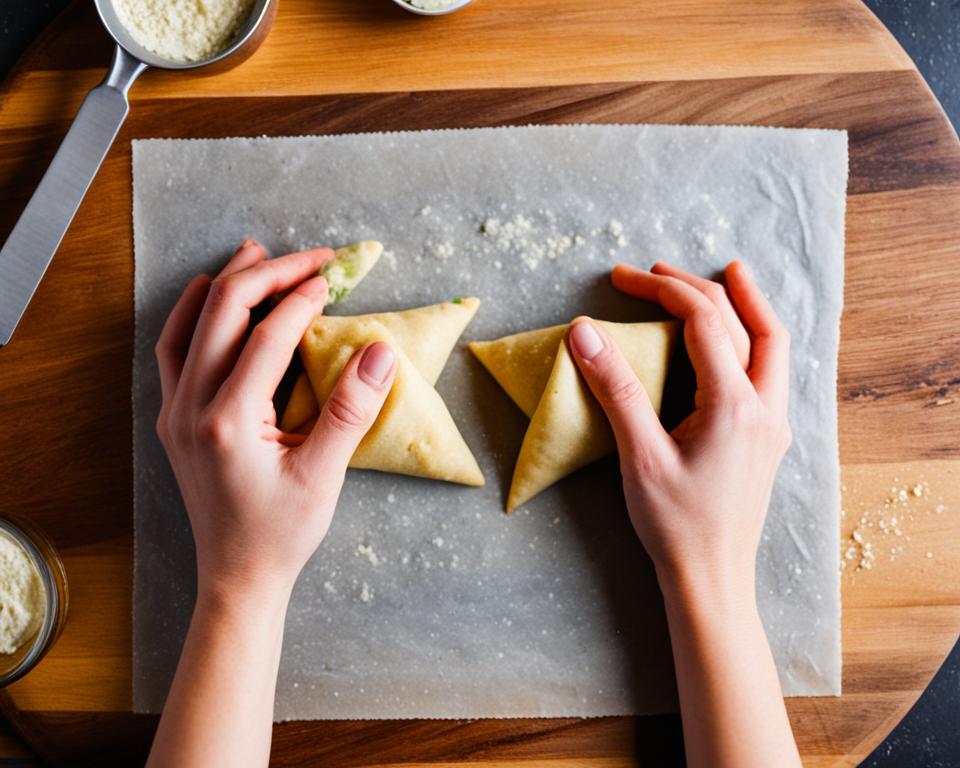
Comparison of Half-Moon Shape and Triangle Shape Samosas:
| Shape | Description | Advantages |
|---|---|---|
| Half-Moon Shape | A semi-circle shape folded into a half-moon. | – Easier to fold – Ideal for beginners – Holds more filling |
| Triangle Shape | A cone shape folded into a triangle. | – Traditional shape – Crispier texture – Perfect for presentation |
Both the half-moon shape and triangle shape samosas have their own unique characteristics. Choose the shape that suits your preference or experiment with both to find your favorite style.
Dipping Sauce for Gluten-Free Samosas
Gluten-free samosas are traditionally served with a tantalizing tamarind dipping sauce. This sauce, made with tamarind paste, water, salt, chili pepper flakes, brown sugar, cumin, and coriander, adds a burst of tangy and sweet flavors to the samosas. The rich and aromatic sauce perfectly complements the spicy filling, creating a delightful harmony of tastes.
Making this delectable tamarind dipping sauce is easy. Just mix together tamarind paste, water, salt, chili pepper flakes, brown sugar, cumin, and coriander in a saucepan. Heat the mixture until it thickens to the desired consistency. Once ready, the sauce is ready to enhance the flavors of your gluten-free samosas.
The tamarind dipping sauce adds a refreshing twist to the samosas, balancing the bold flavors of the filling with its zesty and mildly sweet profile. It’s the perfect accompaniment that takes your samosa snacking experience to the next level.
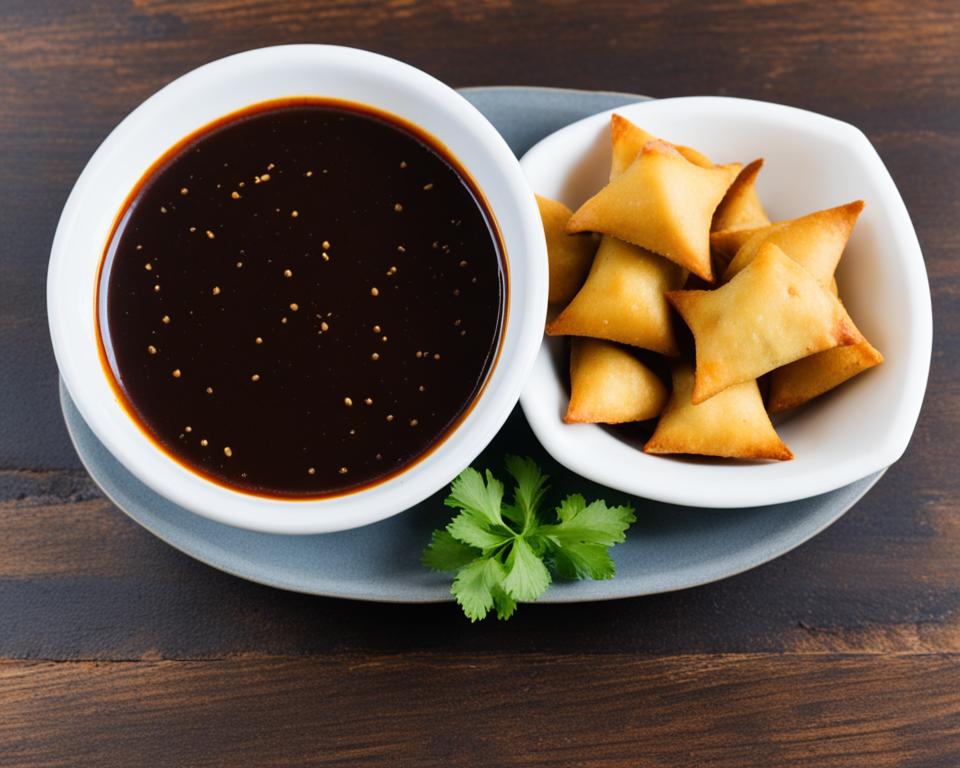
Whether you’re enjoying gluten-free samosas as a quick snack or serving them as an appetizer at a gathering, don’t forget to include the tamarind dipping sauce on your table. Its vibrant flavors will elevate your samosa experience and leave your taste buds craving more.
Freezing and Reheating Gluten-Free Samosas
Gluten-free samosas are a delightful treat that can be made in advance and stored for later enjoyment. Whether you want to prepare a large batch for a gathering or simply save some for future snacking, freezing samosas is a convenient option. Here’s how to freeze and reheat gluten-free samosas to ensure they retain their deliciousness.
Freezing Gluten-Free Samosas
1. After shaping the samosas, place them on a baking sheet lined with parchment paper.
2. Ensure that the samosas are not touching each other to prevent sticking together.
3. Place the baking sheet with the samosas in the freezer and let them freeze until solid.
4. Once frozen, transfer the samosas to a sealed container or freezer bag for long-term storage.
Reheating Gluten-Free Samosas
1. Preheat your oven or air fryer to 375°F (190°C).
2. Remove the frozen samosas from the freezer and arrange them on a baking sheet lined with parchment paper.
3. Bake the samosas in the preheated oven or air fryer for about 15-20 minutes, or until they are heated through and crispy.
4. Alternatively, you can reheat the samosas in the microwave. Place a few samosas on a microwave-safe plate and heat them on high for 1-2 minutes, or until they are hot.
“Freezing and reheating samosas is a great way to save time and have a tasty snack or appetizer at your fingertips whenever you need it.”
Remember to cool the reheated samosas for a few minutes before enjoying, as they can be very hot. The freezing and reheating process may slightly affect the texture of the samosas, but they will still be incredibly flavorful and satisfying.
| Method | Time | Result |
|---|---|---|
| Oven | 15-20 minutes | Crispy and heated through |
| Air Fryer | 15-20 minutes | Crispy and heated through |
| Microwave | 1-2 minutes | Hot and ready to enjoy |
Freezing and reheating gluten-free samosas is a convenient way to enjoy these delicious treats whenever you crave them. Whether you prefer the oven, air fryer, or microwave, you can have crispy and flavorful samosas in just a matter of minutes. So go ahead and make a big batch of samosas to freeze, and you’ll always have a tasty snack or appetizer ready to go!
Tips and Variations for Gluten-Free Samosas
When it comes to making gluten-free samosas, there are a few key tips to keep in mind to ensure the best results. Firstly, it’s important to cool the filling before filling the dough to prevent it from becoming soggy. This will help maintain the crispness of the samosa shell. Additionally, sealing the edges of the samosas properly is crucial to prevent the filling from leaking out during frying. Use a little water to moisten the edges and press them firmly together to create a tight seal.
Now, let’s explore some exciting variations of samosa recipes that you can try to add a twist to this classic dish. Samosas are incredibly versatile, allowing you to experiment with different fillings and flavors. Here are a few ideas to get you started:
- Vegetable Samosas: Fill your samosas with a medley of colorful vegetables such as carrots, peas, bell peppers, and corn. This option is perfect for vegetarians and vegans looking for a nutritious and delicious snack.
- Cheese Samosas: For a cheesy twist, add your favorite cheese, such as paneer or cheddar, to the filling. The melted cheese adds a rich and indulgent flavor to the samosas.
- Meat Samosas: If you’re a meat lover, consider filling your samosas with cooked ground meat such as chicken, beef, or lamb. Add a blend of aromatic spices to enhance the flavor.
- Spicy Samosas: For those who enjoy a kick of heat, amp up the spice level by adding extra chili flakes, chopped jalapenos, or a sprinkle of cayenne pepper to the filling. This variation is sure to satisfy spice enthusiasts.
Don’t forget to play around with different spices and seasonings to create unique flavor profiles. Whether you prefer a mild and aromatic filling or a bold and spicy one, the choice is yours!
If you’re looking for a healthier alternative to fried samosas, you can bake them instead. Brush the samosas with a little oil and bake them in a preheated oven until golden brown and crispy. This method reduces the amount of oil used while still delivering a delicious samosa experience.
Now that you have some tips and variations to inspire your samosa-making adventures, it’s time to get creative in the kitchen and enjoy these delightful gluten-free treats!
Serving Suggestions for Gluten-Free Samosas
Gluten-free samosas can be enjoyed in various ways, whether as a snack, appetizer, or part of a meal. To enhance the flavors and create a delightful culinary experience, consider serving them with a variety of accompaniments. These accompaniments perfectly complement the crispy texture and savory fillings of gluten-free samosas.
Chutneys
Chutneys are a popular choice for serving with samosas. The tangy and flavorful condiments add an extra dimension to the taste profile. Mango chutney, tamarind chutney, and mint chutney are some classic options that pair well with gluten-free samosas.
Yogurt Dip
A refreshing and creamy yogurt dip is another excellent choice for samosa accompaniments. Mix yogurt with fresh herbs like mint or cilantro, add a squeeze of lemon juice, and a pinch of salt to create a cool and tangy dip that complements the spices of the samosa filling.
Salsa
If you prefer a zesty and vibrant accompaniment, consider serving samosas with a homemade salsa. Dice ripe tomatoes, onions, and fresh cilantro, then mix with lime juice, salt, and a hint of chili for a flavorful salsa that enhances the samosa’s taste.
Side of Salad
To make your samosa a complete meal, serve it with a refreshing side salad. A simple salad with mixed greens, cucumber slices, cherry tomatoes, and a light vinaigrette dressing can provide a crisp contrast to the rich flavors of the samosa.
Rice
If you want to make samosas a more substantial part of the meal, serve them with a side of fragrant basmati rice. The fluffy grains of rice provide a neutral base that complements the spices and textures of the samosas.
With these serving suggestions, you can elevate the presentation of gluten-free samosas and offer a memorable dining experience. The diverse accompaniments provide a range of flavors and textures that enhance the overall enjoyment of this versatile dish.
Conclusion
Gluten-free samosas are a delicious and crispy appetizer that is suitable for those with gluten intolerance or following a gluten-free diet. These delectable treats provide a wonderful alternative to traditional samosas, allowing everyone to enjoy the flaky texture and spicy flavors that make samosas so beloved.
By using the right combination of gluten-free flours and fillings packed with wholesome ingredients, you can create gluten-free samosas that are just as tasty as their gluten-filled counterparts. Whether you decide to make them at home or indulge in them at a restaurant, gluten-free samosas will satisfy your cravings and leave you wanting more.
Don’t be afraid to get creative with fillings and experiment with different spices to customize your samosas to your liking. You can try vegetable-filled samosas, cheese-filled samosas, or even meat-filled samosas to cater to your personal preferences. The possibilities are endless!
So, the next time you’re in the mood for a flavorful and satisfying appetizer, consider giving gluten-free samosas a try. With their crispy exterior, savory filling, and perfectly balanced flavors, they are sure to be a hit at any gathering or enjoyed as a tasty snack. Gluten-free samosas offer something delicious for everyone, without compromising on taste or dietary restrictions.
FAQ
Are these gluten-free samosas suitable for vegans?
Yes, these gluten-free samosas are vegan-friendly as they are made with a sweet and spicy chickpea filling and a gluten-free samosa dough.
Can I customize the filling for these gluten-free samosas?
Absolutely! You can experiment with different fillings such as potatoes, peas, lentils, vegetables, cheese, or meats to create your desired flavor.
How do I shape gluten-free samosas?
There are different techniques, but the most common ones are the half-moon shape and the triangle shape. The dough is folded around the filling to create a triangular shape.
What can I serve with gluten-free samosas?
Gluten-free samosas can be served with various accompaniments such as chutneys, yogurt dip, or salsa. They can also be paired with a side of salad or rice for a complete meal.
Can I freeze and reheat gluten-free samosas?
Yes, you can make these samosas in advance and freeze them for later use. After shaping, the samosas can be frozen and reheated in the oven, air fryer, or microwave when ready to serve.
Are there any tips for making gluten-free samosas?
It’s important to cool the filling before filling the dough to prevent it from becoming soggy. Additionally, sealing the edges of the samosas properly is crucial to prevent the filling from leaking out during frying.
What are some variations of samosa recipes that I can try?
You can experiment with different fillings such as vegetables, cheese, or meats. You can also try different spices and seasonings to create unique flavors. For a healthier option, you can bake the samosas instead of frying them.
How can I make the tamarind dipping sauce for gluten-free samosas?
The tamarind dipping sauce is made with tamarind paste, water, salt, chili pepper flakes, brown sugar, cumin, and coriander. The ingredients are mixed together and heated until the sauce thickens.
Can I make the gluten-free samosa dough from scratch?
Yes, the gluten-free samosa dough recipe is made with a combination of gluten-free flours such as corn flour, rice flour, tapioca flour, and potato flour. The dough is mixed in a food processor and then refrigerated before use.
Are these gluten-free samosas suitable for those following a paleo diet?
Yes, these samosas are paleo-friendly as they are made with clean ingredients and are free from gluten and animal products.


